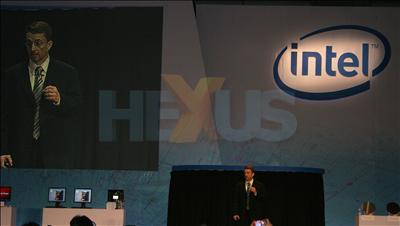Gelsinger talks future Intel processors, and Larrabee
|
by Tarinder Sandhu
on 2 April 2008, 05:17
Tags:
Intel (NASDAQ:INTC)
Quick Link: HEXUS.net/qamhz
Add to My Vault:
|
|
Pat Gelsinger - Intel Senior VP and General Manager, Digital Enterprise Group - kicked off the first official day of Spring IDF 2008 by reiterating the company's desire to continue designing CPUs that, on one hand, perform with up-to petaFLOP performance (really, now, Pat?) and, on the other, run everyday compute tasks with milliwatts of energy consumption - all from the x86 Intel Architecture that has, in 2007, had over $100bn worth of software written for it. Intel backslapping, we think.
Starting off at the top, Gelsinger identified that high-performance computing's need for greater performance remains unabated - medical imaging, genomics research, oil/gas analysis, for example - and will continue to do so. ZetaFLOP computers will be needed for genuinely accurate two-week weather patterns, according to Nasa, which, to put into some kind of context, is a million times faster than the petaFLOP many-CPU supercomputer that Intel expects to build by 2010.
Gelsinger brought on a Chinese suit to demonstrate, for the first time in public, the Tukwila (Itanium) processor for the most demanding computers, using multiple operating systems, in virtualised environments.
Dunnington - the six-core version based on the current Penryn core - is the update for the Caneland (65nm Tigerton Xeon quad-core 7300-series CPUs right now) four-socket platform for enterprise customers. The 1.9bn-transistor, 45nm-based Dunnington core adds in 16MiB of L2 cache whose contents can be shared amongst per-processor cores without traversing the ageing, slow Front-Side Bus (FSB). An incremental update to the existing platform, we reckon. Dunnington will be available in 2H 2008, but the cores' potential will be realised when processors are equipped with a proper interconnect - QPI.
Power is needed, of course, but processors need to be energy-efficient, too. As an example, Gelsinger noted that Intel is a member of Climate Savers, where the aim is to improve HPC/server platform efficiency - as measured by SPECpower_ssj2008 - by 50 per cent by 2010, saving an estimated $5.5bn in energy costs - or the equivalent, in CO2 terms, of removing 11-million cars from the road.
Moving gears and talking about Nehalem, Gelsinger summoned another suit a dynamic-flow model, showing two cars moving around a track and modelling the airflow surrounding them. The suit demonstrated a couple of SuperMicro racks running 512 threads on 32 nodes - high-performance computing in action, kind of.
Pat Gelsinger categorically stated that the reign of rasterisation, as the means for painting pretty-looking images, has come to an end. The incumbent pipeline, is inefficient, he said. The visual computing vision is changing from rasterisation to ray-tracing on many-core IA-based processors - probably known as Larrabee.
Bottom line: Intel hasn't divulged anything new during Pat Gelsinger's keynote speech. High-end servers will receive CPU upgrades during 2008, from Tukwila in the high-end server space to Nehalem in the desktop/HPC sector. But we're still far, far away from realising the kind of compute power needed for environment-affecting events. Power will continue to rise, but not at the explicit cost of energy-efficiency, according to Intel.














